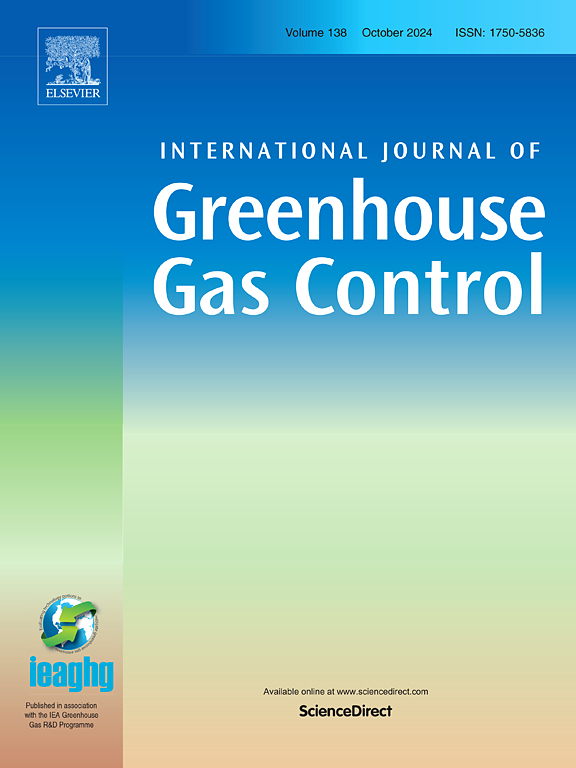直接空气捕获二氧化碳的三周期最小表面的数值评估
IF 5.2
3区 工程技术
Q2 ENERGY & FUELS
International Journal of Greenhouse Gas Control
Pub Date : 2025-09-01
DOI:10.1016/j.ijggc.2025.104457
引用次数: 0
摘要
直接空气捕集(DAC)系统通常由被捕集液润湿的包装材料组成,捕集液与气流中的二氧化碳发生反应。接触器的效率是由流体动力学、传热传质、接触器几何形状和化学性质的复杂关系决定的。接触器的效率必须与其他因素相平衡,主要是通过系统的压降。三周期极小表面(TPMS)是一类微分表面,已在多种工程应用中进行了探索,并在热交换器中显示出优异的性能。它们曲折的路径提供了高的表面体积比和良好的接触面积和压降之间的权衡。在这项工作中,使用计算流体动力学方法对螺线形TPMS接触器进行了各种几何参数的评估,以探索TPMS形状对DAC应用的潜在好处。采用薄膜模型来模拟捕获溶剂的流动和分布,通过消除对计算密集型界面捕获方法的需要,可以在规模上有效地模拟TPMS结构。在商业软件STAR-CCM+中实现液气传质模型,通过分析捕集率、传质系数等相关变量,预测CO2捕集效率,研究捕集性能与压降之间的权衡关系。研究了具有不同几何参数和两种捕获溶剂的TPMS接触器,以确定设计选择对DAC系统运行性能的影响。结果表明,虽然接触器的几何形状是影响效率和压降的主要因素,但溶剂的理化性质是影响接触器性能的次要因素。本文章由计算机程序翻译,如有差异,请以英文原文为准。
Numerical assessment of triply periodic minimal surfaces for direct air capture of carbon dioxide
Direct air capture (DAC) systems often consist of packing material wetted by a capture fluid that reacts with CO in the airstream. The efficiency of the contactor is determined by a complex relationship of fluid dynamics, heat and mass transfer, contactor geometry, and chemical properties. The efficiency of the contactor must be balanced with other factors, primarily pressure drop through the system. Triply periodic minimal surfaces (TPMS) are a class of differential surfaces that have been explored in multiple engineering applications and have been shown to exhibit excellent performance when used in heat exchangers. Their tortuous path provides a high surface-to-volume ratio and favorable trade-off between contact area and pressure drop. In this work, a gyroid-type TPMS contactor was evaluated using computational fluid dynamics for a variety of geometric parameters to explore the potential benefit of TPMS shapes for DAC applications. A thin-film model was employed to model the flow and distribution of the capture solvent, allowing efficient simulations of TPMS structures at scale by eliminating the need for a computationally intensive interface capturing method. A liquid-gas mass transfer model was implemented in the commercial software STAR-CCM+ and used to predict the CO capture efficiency and study the trade-off between capture performance and pressure drop through analysis of capture rates, mass transfer coefficients, and other relevant variables. TPMS contactors with a variety of geometric parameters and two capture solvent options were investigated to determine the effect of design choices on the operational performance of DAC systems. Results showed that while contactor geometry is the dominant factor in efficiency and pressure drop, the physiochemical properties of the solvent are an important secondary influence on the contactor performance.
求助全文
通过发布文献求助,成功后即可免费获取论文全文。
去求助
来源期刊
CiteScore
9.20
自引率
10.30%
发文量
199
审稿时长
4.8 months
期刊介绍:
The International Journal of Greenhouse Gas Control is a peer reviewed journal focusing on scientific and engineering developments in greenhouse gas control through capture and storage at large stationary emitters in the power sector and in other major resource, manufacturing and production industries. The Journal covers all greenhouse gas emissions within the power and industrial sectors, and comprises both technical and non-technical related literature in one volume. Original research, review and comments papers are included.

 求助内容:
求助内容: 应助结果提醒方式:
应助结果提醒方式:


